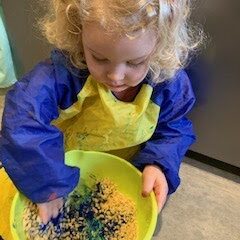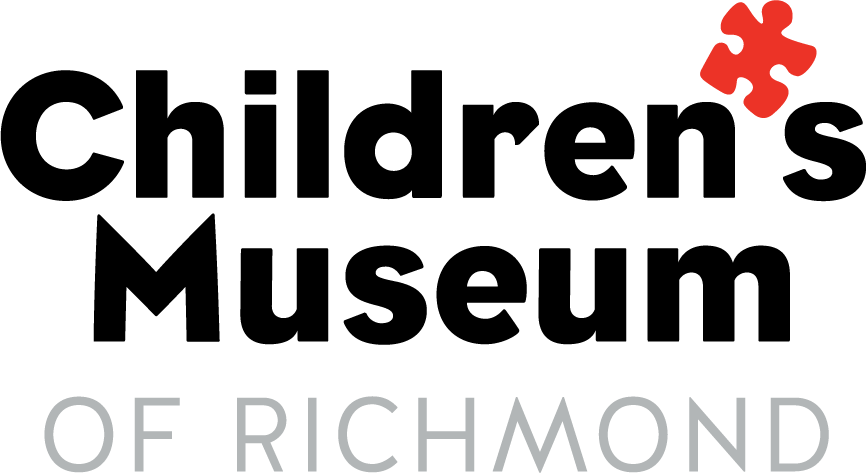Messy Play Day
Learn the basics and benefits of messy play with your child
Published on April 18, 2021

By Mrs. Samuels (Early Years Specialist and Mum)
Our guest blogger this week is a preschool teacher and administrator from England who has been busy entertaining her own toddler during quarantine. As a preschool teacher at a primary school, she sees the benefits of early learning through play as her students are often entering school for the first time.
What is messy play?
Any type of play that provides opportunities for children to get their hands dirty and explore different textures can be classified as messy play. Is it messy? Yes. I will admit that messy play is ‘messy’ – it is supposed to be that way. There will be cleanup involved and you may need to gently hose your children down afterwards. However, with some practice and training, you will be able to have messy play at home without needing to hire professional cleaner at the end of it.
What do I mean by training?
It is important to set boundaries in all play, messy play in particular, so that children can understand what is expected of them and how to safely play. I like to have mats and bins to contain ingredients for our messy play. It has taken a bit of teaching, but my two year old knows that it is okay to spill and get mess on the mat when playing inside. She also knows that it is not okay to take paint (and other things that we use in our messy play) off the mat and squeeze it onto the carpet. Setting ground rules like this are key to enjoying messy play for both you and your child. By providing clear limits, the amount of cleaning up involved afterwards will be reduced and your child’s can play will not be hindered by worrying about what is allowed.
Messy play is about discovery and children should be encouraged to explore as freely as possible whilst respecting your home. It will take you playing alongside your child the first few times you do an activity so they understand how to play and how to explore. Model the playing, cleaning up, and limiting mess as much as possible. Talk about what the two of you are doing to equip your child with the tools of language: “I’m filling my container all the way to the top so it’s full. Do you think you can do that, too?”
Another thing to consider is if you have young children that are still in the ‘explore everything with my mouth’ phase, be sure to use ingredients that are safe if consumed (in moderation of course) and don’t pose risk as choking hazards. I will share activities today that I safely used with my two year old when she was only 11 months old.
Start with play dough
One of my favourite things to make for my little girl is play dough. She gets excited every time we get the ingredients out to make it. Her favourite part is determining what colour dough we will make. This activity in itself is a messy play idea! I let my toddler help scoop out the ingredients, which I will list below, and pour them into the pot. She feels like a big helper and has had a real hand in the making of her dough. We explore colour mixing here as well because she sometimes wants to add more than one colour and of course this causes great excitement when the dough comes out a completely different colour from the two we poured in. Here is the best recipe I have found for play dough:
Ingredients:
1 cup flour
⅓ cup salt
1 cup water
2 tsp cream of tartar
1 tbsp vegetable oil
food colouring of your choice
Instructions:
First pour the flour, salt, oil, water and cream of tartar together in your pot.
Then put your pot on a medium-high heat and get stirring. The mixture will seem very watery at first but trust me, it thickens up in a hurry.
Keep stirring and scraping the bottom of the pot to prevent any dough getting stuck and overheating.
You will notice the consistency start to move from watery to a thick paste and this is when you want to add your colouring. The food colouring isn’t necessary but does make the dough a little more inviting! Here is what your dough should look like from start to finish:
Pull it from the heat when it starts becoming difficult to stir and it begins sticking together and balling up.
Once it is done cooking, place the dough into a bowl and give it a knead. Be a bit cautious because it will be hot. Allow the dough to cool before letting your child touch.
This will keep for the better part of a week if stored in an airtight container when not in use.
Play dough is great for role play and it strengthens little hands which is hugely important in learning how to write. Show your child different techniques of handling the dough, such as rolling or patting, and you will be amazed at where their imagination will take you along the way.
Want more messy play?
Here are a few ideas that you could try out:
Cornflour and water– this creates a really interesting texture that is goopy and hard all at once!
Rice Krispies and paint– listen to them crackle and talk about what you can hear and feel as you mix everything together.
Spaghetti noodles and food colouring– fun for transferring to and from different containers, using different tools, describing textures, and of course role play.
Filling various containers with dried goods such as lentils or rice– great for transporting between containers, practicing pouring, introducing full and empty.
All things water– use brooms, mop, sticks, paint brushes or condiment bottles to make marks on the ground and ‘paint with’.
Writing in flour– use fingers or other instruments such as chop sticks to draw pictures in or practice letter writing
Why do messy play?
Messy play is a great way of letting children learn through their play. Using a broom to move water around the ground may look a bit simple, but for a young child it is developing their understanding of mark making which is the foundation to writing. It is helping them strengthen their core and arm muscles so they can move more safely and with greater care. It is helping them understand cause and effect; if I push the broom this way, the water will go that way too. These simple activities teach our children so much more than we can imagine. It’s also a great way of bonding because children love to see their adults engaging in what they are doing. If they see you getting your fingers covered in paint or drenched in water, it makes them feel like you are on their level and that you want to play with them. And I have to admit, it is pretty fun!
Let CMoR Clean Up the Mess!
Have you tried Creation Stations at CMoR, yet? They are a great way to plan a structured visit to CMoR. These 45 minute lessons include a lesson about the selected topic and an activity that you can complete with your child. Even better, you can book them ahead of time to guarantee your spot. You can view the lessons by looking at the calendar and book by clicking the link. The upcoming Cloud Dough Creating Station would be a great way to make something messy with your child in a controlled environment!
Be sure to share this post and pictures of your messy play with us on Facebook or Instagram.
